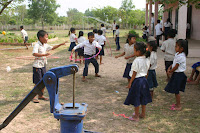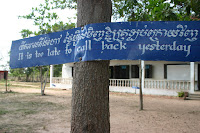 |
|
Kurata School |
We've been running an Activity Afternoon for about a year now, at Spitler School. It's a very simple concept, but you wonder how successful it would be in the UK (or States.) We invite students from the morning session to come into school for one or two hours in the afternoon, for activities, fun - and more English. The very first time we tried it at Spitler we were overwhelmed. And, although we had quite a few volunteers on hand - Jim, Loll, Nick, Jule - it was difficult to cope with the numbers who turned up. We have become more selective over the months, and usually just invite one grade at a time. We try and provide a theme and then introduce a few activities to go withe the theme. Last year we managed a successful couple of weeks with Jack and the Beanstalk. Nick and Jule taught the children some songs, Jim forced the smallest in the class to become a giant, and they acted out the story, and Loll did some practical art work with one group. This Monday we introduced the idea to Kurata school with much more success than we could have imagined.
 |
| Vebol supervises the construction of the garden. |
Kurata School, as you can see from the photographs, is also remote and reached only by dirt track. It's smaller than Spitler and has some way to go in its development. Vebol, the Administrator, is very keen to see the place develop and grow. So we found him proudly directing the construction of a walled garden at the entrance to the school when we arrived.
We had invited the Grade 5 students, who normally come in the morning, for the Activity Afternoon. As this was an entirely new venture we weren't at all sure how many would turn up, but were pleasantly surprised to find that pretty well the whole class had arrived, and were hanging about in the compound waiting for Phouem to finish his Grade 2 class before they could start.


They piled into the classroom at 2 o'clock, and Nick began his old routine: a warm up (stretching and relaxing) followed by the full-action version of The Wheels on the Bus. Luckily for Nick, this was all new to these kids, and they began to join in enthusiastically doing their best to follow his rather ludicrous movements. It helped that they could also see the bus on the computer monitor - though goodness knows what they made of this strange vehicle, which, unlike most Cambodian buses had a windscreen without cracks or holes in it, and a bell to sound to make it stop. And probably some tread on the wheels that went round and round. (There is no public transport in Cambodia, so the idea of a local bus service would have been alien to these children.) They were probably more familiar with the horn, and the baby that went 'wah-wah-wah.'
 |
| School bell |
Our theme today was The Very Hungry Caterpillar, so we read the story and made lots of strange munching sounds and then, when the bell (a car wheel hanging outside, and hit rythmically by a small child with a metal beater) sounded, we went outside with the parachute.
 The parachute:
The parachute: generously donated by Northlight School, Singapore, and beginning to show signs of wear from frequent use at Spitler School, is guaranteed to please the crowds. And it did. Loll is an expert in parachute games, so she kept the children busy - running under and over the fabric, bouncing bean bags on its surface, playing a very energetic game of cat and mouse and finally everyone disappearing into a claustrophobic and incredibly humid mushroom.It is very useful for teaching prepositions but is also very heavy. We might look out for a smaller and lighter version for our little students.





The wheel-bell rang, and we all moved back into the classrooms. Luckily, temperatures on this day were not too high. Recently they've reached 38C, which takes some of the fun out of parachute games. And cycling. And walking, for that matter. The final activity was the creation of their very own butterfly using the scratch cards that had also been donated by Northlight School. The children work quite slowly on these sorts of activities, and completely lack confidence in their skills in free-hand drawing. Loll showed them her design for the cut out, said, 'Right - get on with the drawing and cutting', and they all sat staring at her. So we had to go round and draw the outline for each of them. These are skills which they will no doubt develop in the future. It's not just Kurata, however. We have had difficulties in the past with kids in Spitler school, trying to stop them using a ruler for
all their drawing and writing. Anyway, the results were pretty good in the end, and they all looked very proud of their multi-coloured buterrflies.

A walk around the grounds of Kurata School can be very morally uplifting as the place is dotted with words of sound advice. We have no doubt that the children ponder these words of wisdom on a daily basis.

After you leave the school, through the rather imposing gates, you find yourself back in the heart of Cambodian countryside, with a variety of simple houses dotting the surroundings and one in particular which, at first glance, has something of the English Cotswolds about it: half-timbered and thatch-roofed. It's only on closer inspection that you see that the walls are made of polystyrene lids, and the owner is sitting quietly in front of his home mending a fishing net.




































